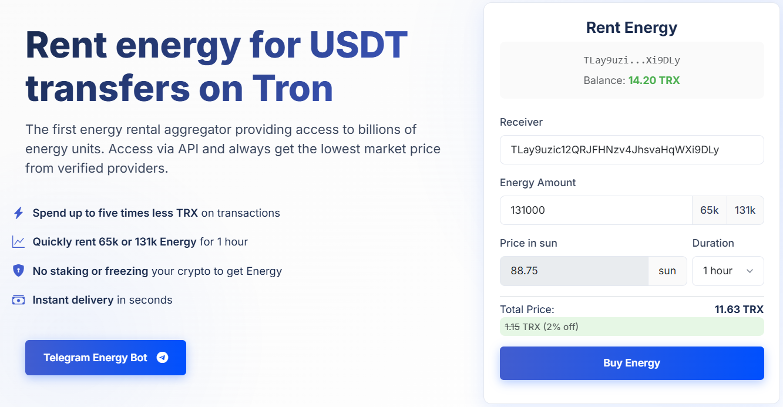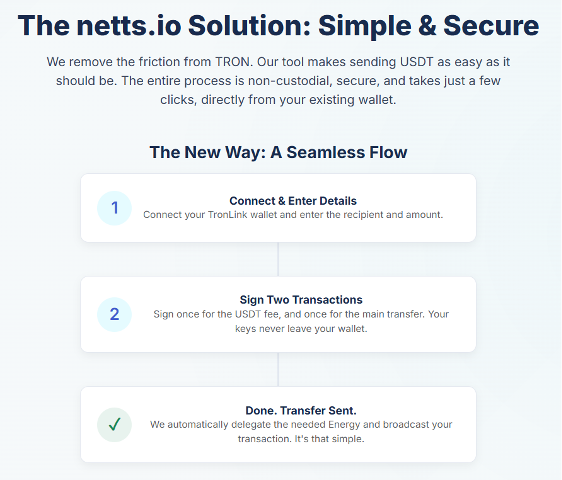The TRON network did not merely adapt to the world of digital assets; in many respects, it shaped the era of the stablecoin. By establishing it as the de facto USDT transfer protocol, it has built a thriving ecosystem which is transacting with billions of dollars of value on a daily basis. Its rise was fueled by the winning combination of high throughput, low and predictable transaction fees, and excellent efficiency - just what dApp, exchange and payment gateway developers around the globe were looking for. This early victory was a revolution unto itself. But for the millions of people fueling this vast ecosystem, the first revolution had an arduous, time-wasting, obstacle at its front door: the “Energy” system. Now, a new surge of progress, spearheaded by Tron energy rental services, is methodically tearing down that last obstacle, carrying on the TRON revolution and the making sure the network is truly in reach and massively cost-effective to all. This post delves into the ways energy rental on the Tron blockchain is answering a core usability and economic issue, turning what was once complicated and expensive into something completely frictionless and on-demand. This transition is not a small upgrade; it’s a huge step forward and breaking new ground for businesses and personal users, reinforcing TRON’s stablecoin dominance in the long-run.
Dilemma of TRON: Low Fees, High Threshold
The operation of the TRON network is based on two main, separate, resources: Bandwidth and Energy. Understanding what they do is key to understanding the profound nature of the problem energy rentals address. Bandwidth: Consider this to be the data allowance for any given transaction. It’s eaten up by every single operation, even the sorts of basic TRX transfers to the more complex dApp actions. Each user gets an allowance of 600 Bandwidth points every day for free, and that’s enough for a few simple, non-contract transactions. Energy: This is the amount of computational energy, or “gas”, that is needed to run smart contracts on the TRON Virtual Machine (TVM). As USDT on TRON is TRC-20 coin (smart contract), every single transaction (however minute) requires a significantly large amount of Energy. Importantly, unlike Bandwidth, there is no ‘free’ daily allocation of Energy. It must be acquired.

This two-resource system eventually led to a huge paradox. TRON was advertised as a low-fee network, however to execute even a single low-fee USDT transaction, a user had to first have TRON’s native token, TRX, in their wallet to pay for the necessary Energy to transact. A regular USDT transfer can range from 13 to 27 TRX if you burn tokens straight up. For a new user, or a business that only held USDT, their accounts were effectively locked down. And, instead, forced into a kludgy, bureaucratic, and frequently bewildering series of processes that belied blockchain’s promise of ease:
- Cancel the proposed transfer, usually after receiving an unhelpful error message about “not enough Energy.”
- Visit a centralized or decentralized exchange and complete the login process including security checks.
- Buy enough TRX, sometimes having buy more than I needed to reach exchange minimum trade limits.
- Pay the exchange’s withdrawal fee and then wait and, again, wait (sometimes minutes) until the TRX ultimately appears in their wallet.
- And lastly, go back to their initial wallet or dApp to retry the first USDT transfer.
This conflict became a major obstacle for the mainstream user to overcome. It took away the very convenience that lured TRON users to TRON in the first place, with a poor user experience which created a major obstacle for non-crypto-native users and businesses seeking to access stablecoins. It transformed a straightforward payment into a multifaceted one.
Solutions: How Tron Energy Renting Will Revolutionize the Game
Tron energy rental services seem to be the graceful panacea in the block that deals with this mess. These mechanisms establish a liquid, on-demand, competitive market for Energy and you can get exactly as much as you want or need for a fraction of the cost of burning your own TRX or staking your own capital.

The economic benefits are enormous and instantaneous. The cost of a standard transfer is 13.4 TRX ($4.15). Instead of spending so much, enthusiasts will resort to Tron energy rental services and rent 65,000 Energy units for as low as 2.6 TRX ($0.81)!!! This is a direct, programmatic cost saving on every single transaction of up to 80%, a game-changing figure for any high-volume business.
Architecture of Access
These platforms work by establishing a sophisticated two-sided marketplace that rewards all participants in the TRON ecosystem. Suppliers (TRX stakers): institutions, validator, and long-term followers of TRON who froze their tokens to secure the network and be part of governance end up generating an extreme amount of Energy that is all too often surplus to their needs. They offer stakers with an option to rent out these excess Energy Assets to other users through Tron energy rental services, providing a new, stable Lou risk yield source for their staked properties. Consumers (transactional users): also those actors who need to transact processing in USDT form, whether individuals or businesses, exchanges or DApps - all can make use of this aggregated pool, full of low-cost and on-demand Energy. Renting Energy in Tron blockchain defies the need for holding TRX to command transactions. That means they don’t need to purchase and hold TRX for the specific act of paying fees. This forms an ideal symbiotic economic cycle: stakers earn money with their idle resources with no added risk and transaction users cut their expenses while increasing their freedom of movement, thus making the entire network more efficient, liquid and accessible. Many of these rental services now have advanced APIs that you can use to fully automate your power acquisition, and refuel your wallets to deal with transaction volume without any human intervention.
Visualizing the Change
The power of this new model is beautifully encapsulated in this compelling infographic by netts.io. It visually juxtaposes the “old way” with a new, smooth process – there is no room for misunderstanding about the revolution in usability. The old way: In the infographic above, you can see an annoying cycle: trading was impossible without TRX, which means you’d have to go back to an exchange, buy some TRX, pull it back out, and then you could finally transfer in some USDT. The Netts way: It’s all very straightforward on the surface, with a three-step “connect your wallet/sign two transactions (one to pay a bit of USDT gas fees and then the actual transfer) and boom - your transaction is sent and confirmed.”

In the background, the service automatically sends the necessary Energy to the user’s wallet to be able to perform the transfer. This abstracts away the network complexity and provides a user experience that is intuitive and seamless.
More than just Convenient: A B2B Revolution through Recipient-Paid Fees
Easily the most important of the innovations described in this infographic is business-oriented feature - the recipient of a transaction can pay the network fee. It solves the number one reason for failed crypto deposits for businesses like exchanges, iGaming platforms, and fintech services. If a user attempts to deposit USDT but does not hold TRX to cover the fee, the transaction will fail. This causes expensive support tickets and a lousy customer experience. By having the receiving business pay the fee, it’s possible to:
- decrease support tickets about missing TRX by 90%;
- boost in successful first-time deposits at a rate of 25%;
- onboard new users as anyone holding USDT can now deposit without first having to purchase TRX.
Turn this simple convenience into a potent B2B solution that eliminates friction, reduces overhead and increases conversion.
The Road Ahead
The future described for TRON has few references regarding BTT’s integration. Services Its services go far beyond being a smart cost-saving utility powered by solar energy, it is the next step inevitably needed to continue the evolution of the TRON ecosystem, wherever the second revolution laying the emphasis on user experience and economic efficiency. By addressing the network’s single most acute usability challenge, they are at last fulfilling what is the ultimate promise of TRON; a platform on which you can make genuinely swift, cheap and effortlessly easy stablecoin transfers. Because they eliminate the complicated and expensive requirement that users hold and manage TRX, this new class of services provides global access to the TRON network for everyone. The revolution is now less about the impressive speed of the underlying technology or low theoretical cost and more about how seamless and accessible the user experience built atop it is. But this critical upgrade to its infrastructure isn’t just about saving cash; it’s about enabling TRON to compete with new-wave Layer 2 solutions and other blockchains that value low user friction. It’s this that will make the environment more appealing for those developers writing the next batch of dApps, in the knowledge that those users won’t be scared away by an esoteric and costly set of network mechanics. This is what takes TRON from a playground for cryptoenthusiasts – in itself quite an achievement – to a global, easy-to-use platform ready for the world of tomorrow’s everyday financial activity.
